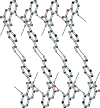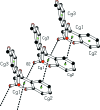2-Oxo-2H-chromen-4-yl 4-meth-oxy-benzoate
- PMID: 23476255
- PMCID: PMC3589019
- DOI: 10.1107/S1600536812047666
2-Oxo-2H-chromen-4-yl 4-meth-oxy-benzoate
Abstract
In the title mol-ecule, C17H12O5, the chromen-2-one ring and the 4-meth-oxy-benzoate side chain are inclined to one another at a dihedral angle of 69.82 (9)°. The crystal structure features parallel sheets of centrosymmetric R2(2)(6) dimers joined by a C(7) chain, resulting in centrosymetric tetra-mers of hydrogen-bonded mol-ecules with graph-set motif R4(4)(40). These centrosymetric tetra-mers are connected by a pair of hydrogen bonds described by an R2(2)(8) ring motif and a C(7) chain via C-H⋯O inter-actions. In the structure, there are also π-π stacking inter-actions between chromene benzene and the six-membered heterocyclic rings [centroid-centroid distance = 3.691 (2) Å] and weak C=O⋯π inter-actions [O⋯(ring centroid) distance = 3.357 (3) Å].
Figures




References
-
- Basanagouda, M., Kulkarni, M. V., Sharma, D., Gupta, V. K., Sandhyarani, P. & Rasal, V. P. (2009). J. Chem. Sci. 121, 485–495.
-
- Bernstein, J., Davis, R. E., Shimoni, L. & Chang, N.-L. (1995). Angew. Chem. Int. Ed. Engl. 34, 1555–1573.
-
- Burla, M. C., Caliandro, R., Camalli, M., Carrozzini, B., Cascarano, G. L., De Caro, L., Giacovazzo, C., Polidori, G. & Spagna, R. (2005). J. Appl. Cryst. 38, 381–388.
-
- Emmanuel-Giota, A. A., Fylaktakidou, K. C., Hadjipavlou-Litina, D. J., Litinas, K. E. & Nicolaides, D. N. (2001). J. Heterocycl. Chem. 38, 717–722.
-
- Farrugia, L. J. (2012). J. Appl. Cryst. 45, 849–854.
LinkOut - more resources
Full Text Sources
Research Materials
Miscellaneous
